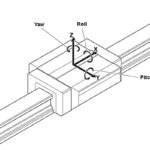You might be familiar with rotary needle roller bearings (often referred to as simply needle roller bearings) which are used extensively in automotive and industrial power transmission applications due to their compact size and high load-carrying capability. But did you know that some linear bearings also use needle rollers?
For linear bearings, needle rollers were first incorporated into non-recirculating linear guides, but manufacturers have recently introduced recirculating profiled rail guides with needle roller bearings to meet ever-increasing demands for rigidity and smoothness of motion.
How do needle rollers differ from cylindrical rollers?
The key difference between cylindrical rollers and needle rollers is the roller’s length-to-diameter ratio. To be categorized as a needle roller, the roller’s length must be at least 3 times its diameter. In fact, needle rollers can have a length-to-diameter ratio between 3:1 and 10:1, whereas cylindrical rollers have a length-to-diameter ratio of less than 3:1.
The traditional load-carrying components in linear bearings — both recirculating and non-recirculating types — are either balls or cylindrical rollers, both of which provide high load capacity, low friction, and good rigidity for linear motion applications. But just as cylindrical rollers offer a “step up” in performance over balls — especially in terms of load capacity and rigidity — needle rollers offer even better performance than cylindrical rollers in some respects.

Image credit: Schneeberger
In radial bearings, one of the main reasons for using needle rollers is their compact size, but in linear bearings, the main benefits of needle rollers over balls or cylindrical rollers are even higher load capacities and better rigidity. This is because when needle rollers are used, the load is distributed among more, smaller rollers, each of which has a larger contact area than a cylindrical roller (due to the needle roller’s longer length). This reduces the pressure per roller and allows the bearing to carry higher loads. Less load per roller also means less deformation and, therefore, higher rigidity. In fact, the rigidity of a needle roller linear bearing can be up to 50 percent higher than that of a cylindrical roller version.

Image credit: Nippon Bearing

Image credit: Nippon Bearing
For recirculating profiled rail bearings, needle rollers also provide smoother motion in two regards. First, needle rollers have higher dynamic (running) friction than balls or cylindrical rollers. Although higher running friction is, in some applications, a negative trait, in the case of high-load, high-rigidity linear guides, the increased running friction can be a benefit since it serves to dampen vibrations due to external forces. And with the load dispersed over more, smaller rollers, vertical pulsation of the bearing caused by motion of the rollers is also reduced.
While rotary needle bearings can be made with or without a cage, depending on the application and mounting requirements, both recirculating and non-recirculating linear bearing designs contain the needle rollers in a cage. The cage prevents skewing and misalignment, ensures the needle rollers are evenly loaded, and prevents de-rating of speed capabilities. And for non-recirculating designs, cages are offered with anti-creep, or “cage control” mechanisms to ensure the cage remains in its centered position.
It’s important to note that because needle roller linear bearings use more, smaller rollers than ball or cylindrical roller designs, there is less space inside the bearing for lubrication to be retained. Therefore, proper lubrication can be even more critical with needle roller linear bearings than with ball or cylindrical roller versions.
In non-recirculating linear bearings, needle roller designs fit applications that require higher load capacities and better rigidity within the same (or similar) dimensions as traditional ball or cylindrical roller versions. In recirculating profiled rail bearings, needle roller designs meet application demands — often found in the machine tool industry — for extreme rigidity and the smoothest motion possible.







Leave a Reply
You must be logged in to post a comment.